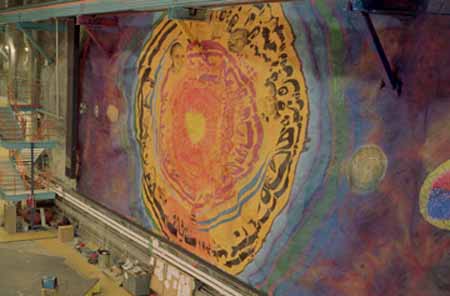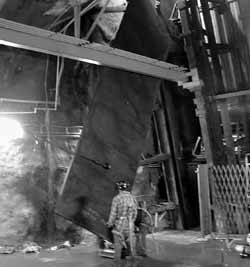 |
|
A Deep Sense of Place
Soudan iron mine offers neutrino science some bedrock support by Mike Perricone
SOUDAN, Minn.— If Gertrude Stein had ever visited this far northeastern
corner of Minnesota, she probably would have written about the Soudan region
in the same way she did about Oakland, California: “There is no there, there”
But that’s all right, because the people up here like it that way. And they’d
know that Gertrude Stein never worked in a mine. Most people up here have,
one time or another, often through more than one generation, and often
through lean times.
The number of miners is seriously declining in this region, called the Iron
Range since rich ore deposits were discovered in 1865. The underground
mines have largely given way to surface mining, which requires less labor, is
amenable to mechanization, and produces far more ore from less-concentrated
deposits by processing more rock, faster and cheaper, crushing the rock and
separating the ore magnetically. Quantity outstrips quality.
But the underground mines remain. The Soudan Underground Mine is one
of them, a national historic landmark since 1966—and a physics laboratory
since 1979. With commendable foresight, the state of Minnesota has sought
alternatives for more than 60 years to an over-dependence on mining for the
economy of the region. The Iron Range Resources and Rehabilitation Agency
was created by the 1941 Minnesota Legislature to help ease northeastern
Minnesota’s dependence on the natural ore and timber industries.
The cavern housing the detector for the Main Injector Neutrino Oscillation Search, where nearly half of the projected 486 detector planes have been assembled and installed. The mural is 59 feet wide and 25 feet high.
The Soudan Underground Mine was closed in 1963 and placed on the National
Register of Historic Places in 1966. It is operated as a state park by the
Minnesota Department of Natural Resources,
with 14 tours a day taking the fast and clamorous
elevator ride nearly a half-mile below the surface.
After descending, hard hat-wearing tourists can
view old mine caverns with some of the equipment
still standing in place.
Since Memorial Day, tourists have also been able
to view the cavern housing the detector array for
the Main Injector Neutrino Oscillation Search—
nearly 500 assemblies of steel, scintillating plastic
and electronic readouts, shaped like 28-foot stop
signs, hung like file folders, each weighing 12 tons.
The completed array will weigh 6,000 tons, about
equivalent to a naval battleship, aimed at halting a
small portion of the neutrino beam sent through the
earth from Fermilab.
The tourists can also catch a glimpse of real
miners—although these miners are now working
for the University of Minnesota, assembling and
mounting the detector planes that will halt a
handful of neutrinos a day when the experiment is
up and running, around 2005. The working crews
were drawn largely from some 1,400 people laid
off when the LTV Steel Mining Company shut
down its facility in nearby Hoyt Lakes in May, 2000.
It was just about that time that MINOS detector
construction began.
“You never like to have good fortune based on
someone else’s bad fortune,” said Assistant Lab
Manager Jerry Meier. “But with the LTV layoffs,
we were able to bring in people with excellent
skills and experience. We really have quality
crews working here.”
The crews work 10-hour shifts, four days a week.
They work quickly, quietly, efficiently and fastidiously
—the cavern floor glints under the stark white
lighting. They work so well, in fact, that the
production schedule had to be changed—because
the crews were running ahead of the predicted
rate for assembling and mounting the detector
components shipped from Fermilab.
The assembly work in the cavern is quietly
impressive, but the process of getting the
components down the narrow elevator shaft
is stunning.
The materials are delivered three times a week
at 5:30 p.m., after the day shift and public tours
have ended. The work is highly dependent on the
weather, especially the wind conditions. When
it’s windy, the crews can’t unload the boxes of
scintillating plastic, which are about 30 feet long.
“We won’t let them unload the scintillator if the
winds are above 25 mph,” Meier said. “The
detector plate sections are heavy enough to
withstand the wind, but the boxes of scintillator
are too light and too hard to handle in the wind.”
Watching the preparations, the unloading, and the
elevator descent is like witnessing a combination of
ritual dance and close order drill. The crew begins
by essentially dismantling the elevator car, or cage,
removing the sides and top. A pulley from the mine
headframe begins slowly drawing the component—
either the long wooden crate or the six-ton package
of half a detector section—off the delivery truck. It
takes so much space to shift the material from the
horizontal to the vertical that part of the headframe
support had to be removed
and reconfigured. While
the load is hanging
there, and changing its
orientation, the crew guides
it to rest in the cage. Then
it is sent 2,341 feet down the shaft to level 27, and
unloaded by a similar process onto a track that
carries it to a staging area in the cavern. Not a
word or motion is wasted.
The operation can extend well into the night, as
late as 3 a.m. For some of the crew members, this
is not their only job. But they’re accustomed to
working two jobs if necessary, shifting jobs
because of layoffs or mine closings, or just
because times aren’t what they used to be.
Physicist Earl Peterson of the University of
Minnesota has been part of the underground
laboratory operation since 1979, when the proton
decay experiment (Soudan II) began. He’s watched
this sort of work performed for more than 20 years.
“These people have always lived here, and this is
where they want to be,” Peterson said. “They’ll do
what it takes to stay here.”
Mines aren’t the only feature of the area, or the
only resource. Minnesota calls itself “Land of
10,000 Lakes,” which is probably an underestimate
given the innumerable inland basins in this heavilyforested
region alone. The forest is a threedimensional
curtain of towering but stick-thin
evergreens. Any peek through the curtain is likely
to reveal a lake with miles of densely wooded
shoreline interrupted by just a handful of clearings
for prized and longstanding lakefront hideaways.
The prevailing sentiment seems to be the fewer of
those, the better—though many of them are having
DSL lines installed.
“The city populations are
declining, and we are
seeing more people move
into the rural areas,” said
Lab Manager Bill Miller,
who built his own home and has been living on a
quiet lakefront property for more than 25 years.
“With the growth of the Internet, people are
realizing they can live and work and be connected
just about anywhere.”
Direct communication is still a priority on the
project, and Miller frequently drives to Fermilab
and back for meetings—a trip that can take as
much as 10 hours each way (the neutrinos,
meanwhile, will cover the straight-line distance
of 450 miles in 0.0025 seconds). But distance
driving seems to be the norm in this region.
Miller has been known to drive with his wife
on a Saturday to attend a Fermilab Arts Series
presentation that night.
“Oh, it’s not that bad a drive,” he said with a shrug
and a smile.
The arts have also reached down to Level 27 and
made quite an impact. The University of Minnesota
Foundation commissioned a mural for the MINOS
cavern—a mural painted onto the rock wall, 59 feet
wide by 25 feet high. The artist, Joe Giannetti of
Minneapolis (whose accent betrays his origins
in Brooklyn, New York), did his painting while
dangling from a sling suspended from a support
beam near the roof of the cavern. His distinctive
technique was featured in a recent National
Geographic television documentary about the
MINOS project.
Giannetti was challenged, not only to find the right
paint to adhere to the rock, but also to overrule his
instincts in placing the image on the undulating
surface. He had to steel himself to be guided by
the image projected onto the wall from a slide
projector across the cavern. Distortion in the close
view translated to a normal image viewed from the
second-level visitors’ gallery across the cavern.
The mural’s fiery central focus area contains
images of scientists such as Enrico Fermi and
Wolfgang Pauli, Wilson Hall at Fermilab, George
Shultz, a key figure in the history of Minnesota
mining, and a number of surprises.
Scientists, miners and an artist have combined to
create a special sense of place on Level 27. All
that’s required is looking beneath the surface.
NuMI-MINOS
MINOS Mural Project
|



 A phone call brought Miller the news that another
neighbor was, indeed, interested in signing up for
DSL. Miller explained that it would take five
subscribers to get a line run out to the lake.
“Now we just need two more,” he said.
A phone call brought Miller the news that another
neighbor was, indeed, interested in signing up for
DSL. Miller explained that it would take five
subscribers to get a line run out to the lake.
“Now we just need two more,” he said. “The easy way out would have been to fill the
horizontal space with a horizontal time line,”
Giannetti said. “But I wanted a focus that would be
the same from any angle, and not be lost from one
end to the other. I’ve included the word ‘change’
in as many languages as people could give me
translations for it. Neutrinos are changing all the
time—just as we are, just as the universe is. I’m
fascinated by neutrino science, and I admire the
imaginations of the scientists. A scientist had to
imagine this experiment, this series of detectors.
This place is a temple of the human imagination.”
“The easy way out would have been to fill the
horizontal space with a horizontal time line,”
Giannetti said. “But I wanted a focus that would be
the same from any angle, and not be lost from one
end to the other. I’ve included the word ‘change’
in as many languages as people could give me
translations for it. Neutrinos are changing all the
time—just as we are, just as the universe is. I’m
fascinated by neutrino science, and I admire the
imaginations of the scientists. A scientist had to
imagine this experiment, this series of detectors.
This place is a temple of the human imagination.”